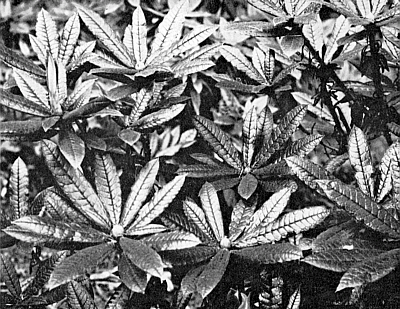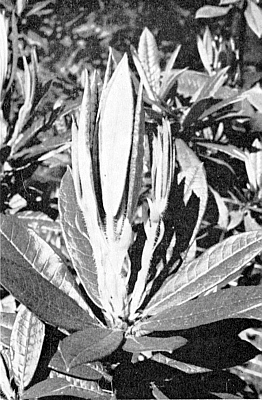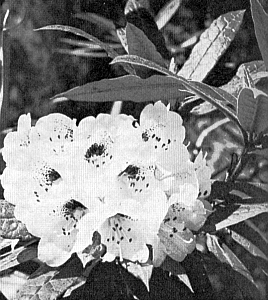QBARS - v26n4 Some Plants From the Barbatum Series
Some Plants From the Barbatum Series
Carl Phetteplace, M.D., Eugene. Ore.
Since "the beard" and "the hair" are so much in the limelight at the present time, why not mention some of our rhododendrons that are distinctive for their hirsute appendages. This of course brings us to the Barbatum Series. There are a half dozen or so in my garden about which some notes may be of interest. R. pseudochrysanthum and R. strigillosum will not be commented on because the former was described in the Bulletin of the A.R.S., Vol. 25, No. 3, July '71, and the latter is quite widely distributed and familiar. Most to be commented on are from seed grown from Dr. Rock's last expedition in 1948 and are somewhat rare. Generally they have been grouped as R. crinigerum . This they may not all be, but at least they are in the Barbatum Series. All have flowered in my garden several times.

|
| FIG. 89. Close up of budded Rock #2, R. crinigerum |
First is Rock # 2, which is now a shrub easily 5 by 5 feet in dimension. The leaf is elliptic with an acute apex, 3 to 5 inches in length and 1 to 1½ inches in width. It is a deep glossy green on the upper surface with the veins so deeply impressed as to make the leaf almost bullate. The under surface is heavily clad with a light brown suede or felt-like indumentum. The stems are quite covered with bristles or heavy hairs which extend up the petioles and for some distance up the midribs. Under the lens it is seen that most of the bristles are topped with a gland. These bristles remain on the old wood 3 years or more. The flowers are 5-lobed, white with strong pink markings. They are campanulate, measuring about 1½ inches in length and width, and make a loose truss. The very attractive foliage is retained 2 or 3 years or even more. Because of the attractive foliage and indumentum the plant is always noted by visitors at any season. It has proved rather easily rootable.
Rock #3 is less heavily bearded and the leaf is slightly more oval with an apiculate apex. It measures 2 to 3½ inches in length by 1 to 2 inches in width. The stems and petioles grossly are moderately bristled, but under the lens again they prove to be setose glands. The upper surface of the dark green leaves appear glossy, dark green with moderately impressed rib and laterals. Below, grossly there seems to be a thin brown plastered indumentum, but on magnification this proves to be a dense population of small tufts of brown hairs. The flowers on this plant are a pale yellow, 5-lobed campanulate and perhaps slightly larger than that described above. They have a small bright red blotch in the throat.
Although all of these bearded Dr. Rock numbers have been called "Crinigerum" it is well known that conditions at the time he was working in the area necessitated some haste in getting out if he were to avoid harm. Consequently the doctor himself said there was bound to be some inaccuracy and discrepancy between field numbers, herbarium material and the identity of the plants grown from seed. This has been pointed out in a report from the Royal Botanic Gardens in the A.R.S. Bulletin, Vol. 10, No. 4, p. 204, and elsewhere. Thus some knowledgeable people have considered R. #3 not really R. crinigerum but rather R. bainbridgeanum . Actually the description in the Species Book rather bears this out. Anyway it is a good garden plant and very floriferous in full sun. It does need rather stern pruning in early years to make it a shapely plant. Now it is over 5 by 5 feet in dimensions.
Rock #38 must be one of the most heavily bearded rhododendrons in cultivation. It is also about 5 feet tall and rather like R # 2 except much more bristled. The foliage possibly is a little more bullate and the suede or felty indumentum is slightly more rusty brown and on magnification is a tangled mat of hairs. Again the bristles are really setose glands. The bristles cover the stem and petiole and extend more sparsely up the midrib. Again they remain on the branches for a few years. The flower is almost identical with that of R#2-white and pink and of good substance.
|
|
Rock #100 is quite different. This is another that needs much pruning in early years to develop an attractive shape. The leaf is longer and more slender than the others (about 1¼ by 5 inches) but has the same glossy, bullate upper surface. The bristles are much more sparse than seen on the others but similar in having the dark glands on the tips of the hairs as seen under the lens. The indumentum is almost pure white, maturing a pale lemon yellow but in all other respects the same as that of R#2 and R#38. The flower also is different in that there are at least twenty flowers that make up a tight, globe-like truss. They are clear white with a prominent, very dark blotch or eye. It is very showy indeed in a good year. It must root readily, because I have been successful once.
A fifth member of the Barbatum Series as near as I can recall came originally from Else Frye. I have lost the label and record of it. It is a shapely but slower growing shrub. The leaves are deep green with depressed veins. One is surprised to see on the upper surface under the lens a fairly thick population of tiny nests of small brown hairs. There is also a thick row of short hairs along the entire margin of the leaf. These also are for the most part capped with glands. There is no gross indumentum but the stems and petioles are heavily clad with distinctly red setose glands. The petiole and leaf bud scales are very dark red. If this plant is ever named it could well be called "Red Whiskers", because the bristles themselves are so thick and red. The flowers are again campanulate, about the same size as those described above, and are a very dark pink with dark maroon basal blotch. It has a striking, rather thick, toothed calyx, much longer on one side than on the other. For this reason my knowledgeable visitors have opined that this was R. diphrocalyx . The plant needs no pruning to keep it compact and very attractive.
To round out my family of hairy plants there is a plant of R. barbatum itself visible from our dining table that gives us much pleasure. It came from the Barto collection and is probably over 40 years old. It too has dark, glossy, deeply veined foliage. However the beard is almost non-existent, but can definitely be seen on the new growth for a time. This form has been dubbed the "hairless Barbatum". It is now about 8 feet by 6 feet. The trusses are made up of 20 or so florets, snugly packed to make a ball-like truss 5 inches or more in diameter. In late March most years it is a striking pillar of deep crimson, the flowers staying in good condition for a month or more despite our usual March weather. A dozen times I've tried to self-pollinate it without success. Nor are the bees any more successful. The bark on this plant is striking in that it is a deep chocolate brown and perfectly smooth. One gets a rather poor percent of successfully rooted cuttings from this one, which is unfortunate.
All these plants have gone through periods of near zero weather in winter and none have shown any injury except one year after about 3 weeks of unusually warm weather in late February and early March R. diphrocalyx , which was starting to bloom, was badly hurt. But ordinary cold and wind of midwinter does none of them any harm to either shrub or buds. It would make me happy to have more representatives of this interesting series in the garden.


